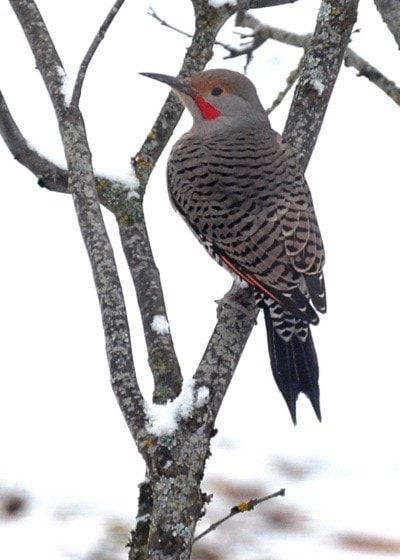This winter interesting birds seem to be cropping up more than usual. A recent unusual sighting is a close “relative” of that both popular and unpopular flicker, at times not acting like my friend. The flicker is a pleasant sight when eating cracked corn from the feeder or from the ground around the feeder. The flickers, on my place, also visit one of those towering ant hills, leaving gaping holes in the sides where they have extracted a few of the half frozen occupants.
Flickers are an eye-catching patterned and colored bird, admittedly, even when found pecking on the cedar siding of my cabin in search of overwintering flies, which may be stopped by filling in joins and cracks in the siding. I didn't intend for the cabin to become a flicker feeder. But, voila, perhaps I have found a solution in providing cracked corn for those handsome birds. It was at a feeder that a somewhat different flicker of another sort showed up. Now flickers are being eyed a little more closely.
Many of us are content with the name “flicker” for this woodpecker-like bird but to many it is also known as the northern flicker, which also includes another flicker, one with different colors and markings, which is the object of closer scrutiny of our flickers. Our local flicker is salmon-red on the underside of the wings and tail; however this different one is brilliant yellow in the same areas. Ours is referred to as the red-shafted race and our unusual flicker showing is called the yellow-shafted race of the northern flicker, or common flicker. On this flicker, look for a crescent-shaped red patch on the back of the neck (nape). Initially, these two flickers were considered to be separate species, but now they are listed as one species, including these two geographical races, which hybridize freely where their ranges are adjacent.
Historically, it seems, populations of these two variations, the red-shafted and the yellow-shafted, were separated from each other by the great plains or prairies, an unfavorable environment not having much forest land, their favorite haunt. The red-shafted flicker inhabited woodlands west of the Rockies and the yellow-shafted occupied forestland east of the Prairies in eastern North America. Concentrated populations are found, respectively, in these same regions today. It is possible that human settling and subsequent creation of pockets of forest in towns and cities across the prairies has enhanced hybridization and the spread of the yellow-shafted race to the Rocky Mountains.
It is unusual for the yellow-shafted race to show up, or at least be spotted here in the Creston area. Years ago, one was found dead along Lower Wynndel Road. It could have been hit locally or hit by a vehicle in Alberta and transported on the front of the car to its final destination. Our recent acclaim to a yellow-shafted flicker was detected by the observing eye of a local feeder watcher.
Another difference in the yellow-shafted flicker race is that the males have a black “moustache”, while males of our local race have a red moustache. It is some of these different details that our spotter saw in this bird that was, true to habit, feeding, unlike most members of the woodpecker clan, on the ground. The color patterns of the two flicker races are quite similar; however, some of the colors are different. They are very similar in their habits and generally only differ in their habitats, feeding and nesting as dictated by their environments. There are a lot more fascinating bits about these birds and their life waiting there for us all to discover. Looking for the yellow-shafted personality may enhance your pleasure of feeder watching. Your yard may be the only big TV screen worth watching.
As a youth, my first introduction to the eastern flicker, the yellow-shafted race, was by the name of “yellowhammer”. In the past, flickers seem to have been a favorite with country people because they have attained a list of over two dozen names.
Well check out your flicker friends — you might spot a yellow hammer!
Ed McMackin is a biologist by profession but a naturalist and hiker by nature. He can be reached at 250-866-5747.
